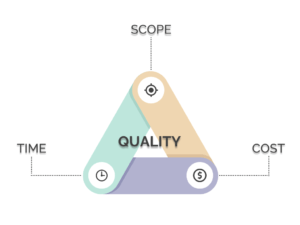Discover how a project management framework can transform your approach to buying or selling a home, turning complex decisions into strategic victories.
With decades of project management experience in the aerospace industry and as a management consultant for a global consulting firm, I’ve been at the forefront of guiding projects to successful completion under the most stringent constraints. This background has given me a deep appreciation and unique insight into the delicate balance required to manage time, cost, and scope—elements known in project management as the triple constraint theory. Upon transitioning to real estate, I quickly recognized how this foundational theory directly parallels the intricacies of buying or selling a home. Utilizing this concept, I’ve skillfully advised and guided my clients through the competitive landscape of Sonoma County’s real estate market, ensuring their journey is not only successful but empowering.
The Triple Constraint Theory: A Primer

At its core, the triple constraint theory in project management states that a project’s quality is defined by its scope, time, and cost. These three constraints form a triangle, with each side representing a constraint. Change one side, and the other two must inevitably adjust to maintain the project’s integrity. This theory is pivotal for project managers across industries, offering a lens through which to evaluate decisions and predict their impacts on a project’s outcome.
Applying the Triple Constraint Theory to Real Estate
When buying or selling a home, the triple constraint theory becomes a powerful metaphor for understanding the interplay between three critical factors: price (cost), timing (time), and the property (scope). Let’s delve into how this concept can be practically applied to real estate transactions, offering buyers and sellers insights into navigating their real estate journeys more effectively.
For Buyers: Balancing Dreams with Reality
Imagine you’re embarking on the journey to find your dream home in Sonoma County’s competitive real estate market. Here, the triple constraint theory becomes your roadmap.
Price (Cost): Your budget sets the baseline. It’s the financial constraint within which you must find a property that meets your needs. Understanding your budget’s flexibility—or lack thereof—is crucial in setting realistic expectations. For example, if you’re eyeing a property slightly above your budget, assessing the market dynamics might reveal whether it’s worth stretching your budget or if waiting for a more opportune moment could bring prices within reach.
Timing (Time): The current market conditions, including inventory levels and buyer competition, significantly impact your buying experience. In a seller’s market, you may need to act quickly and be more flexible with your other constraints to secure a home. This might mean being ready to make an offer swiftly or considering homes requiring some work to meet your ideal standards.
Property (Scope): This encompasses the home’s size, location, amenities, and condition. But, beyond these tangible aspects, the true scope delves into the emotional drivers of a home, focusing not just on the number of bedrooms and bathrooms but on understanding your deeper desires and life aspirations. It’s about uncovering the essence of what you seek in a home—be it a haven for growth, a space for gathering, or a sanctuary for creativity and peace. Prioritizing these elements according to your needs and desires is essential, but remember, adjustments in one area may require compromises in another. For instance, you might find a property in your preferred location but might have to compromise on size or accept that some renovation work is needed to make it your dream home.
For Sellers: Maximizing Value
Selling a home also demands a strategic approach informed by the triple constraint theory.
Price (Cost): Setting the right asking price is a balancing act. Price too high, and you may alienate potential buyers, too low, and you might not realize the property’s full value. Understanding market trends and buyer expectations in Sonoma County is key. A strategic pricing approach might involve setting a competitive price yet slightly below market value to spark interest and potentially a bidding war.
Timing (Time): The optimal time to sell can vary, influenced by market conditions, seasonal trends, and your personal circumstances. Timing your sale correctly can significantly affect the sale speed and the price. For example, listing your property in the spring, when buyer activity typically increases, could shorten the sale process and improve your chances of securing a favorable price.
Property (Scope): Enhancing your home’s appeal through staging, renovations, or simply addressing repair issues can significantly impact its marketability. Deciding where to invest in improvements should be guided by what will most effectively increase the home’s value within the time and cost constraints. For instance, investing in minor cosmetic updates that have a high return on investment can make your home more appealing without necessitating a large budget or extensive time commitment.
Real-Life Scenarios
Consider a buyer in Sonoma County, enamored with the idea of owning a sprawling vineyard estate. Their budget (cost) is set, but they’re flexible on timing (time) and have specific requirements for the property (scope). Guided by the triple constraint theory, they prioritize the property’s features and are willing to wait for the perfect match, even if it means slightly stretching their budget.
Conversely, a seller looking to relocate quickly for a job opportunity might prioritize timing (time) and be willing to adjust the price (cost) and make necessary improvements (scope) to ensure a swift sale.
Leveraging the Triple Constraint Theory
Understanding and applying the triple constraint theory in real estate transactions is not just about recognizing the theory but about employing a strategic mindset that enables you to navigate the complex and often emotionally charged journey of buying or selling a home. Here’s how to deepen your engagement with this concept, ensuring you leverage it to your maximum advantage.
Define Your Priorities
The first step in effectively leveraging the triple constraint theory is clearly defining your priorities. This requires a thoughtful assessment of what you value most in the transaction. Are you primarily driven by the need to stay within a strict budget, or is the timing of the sale or purchase more critical due to personal or professional deadlines? Perhaps the specific features of a property—such as its location, architectural style, or the lifestyle it enables—are non-negotiable for you.
This prioritization goes beyond mere preference; it’s about understanding your core objectives. It’s about understanding emotional drivers, digging deeper, and finding the space between the lines—where the true essence of a home is discovered. For buyers, this might mean recognizing that living in a specific school district is paramount for your family’s happiness and educational goals. For sellers, it could be realizing that maximizing return is secondary to a fast sale due to an impending relocation.
Assess Your Flexibility
Once priorities are set, assessing your flexibility around these constraints is next. This introspection is vital because it determines your negotiation power and ability to adapt to market dynamics. Flexibility might manifest in various ways—perhaps you’re open to exploring different neighborhoods if it means finding a home that meets all your other criteria, or maybe you’re willing to extend your timeline to sell at a higher price.
Flexibility also involves preparing for the unexpected. In real estate, as in life, things rarely go exactly according to plan. A buyer might suddenly find themselves in a bidding war, or a seller might face unforeseen repairs after a home inspection. Your ability to navigate these situations without losing sight of your overall goals is crucial.
Consult with a Real Estate Professional
The final and most critical step is to consult with a real estate professional who not only understands the triple constraint theory but also knows how to apply it in the nuanced context of the Sonoma County real estate market. A skilled advisor brings a wealth of experience and market insight, helping you to interpret market trends, evaluate the feasibility of your priorities, and strategize accordingly.
This professional guidance is invaluable, especially when faced with complex decisions or unexpected market shifts. Your advisor can help you reassess your priorities and flexibility in real-time, ensuring your strategy remains aligned with your objectives. They can also serve as an objective voice during emotionally charged moments, helping you to make decisions that are in your best long-term interest.
Conclusion
By leveraging the triple constraint theory through defining your priorities, assessing your flexibility, and consulting with a professional, you’re not just navigating the real estate market but mastering it. This approach empowers you to make informed, strategic decisions, whether buying your dream home or selling a cherished property. It transforms the real estate process from a daunting challenge into a manageable project, where every decision is a step towards achieving your goals.
Ready to get started?
If you are interested in selling your home in Sonoma County, contact Tim DeBellis for the guidance you can count on. From luxury homes in Healdsburg, CA, to gorgeous Santa Rosa properties, Tim knows all the top tips for selling your home as seamlessly as possible. Get started today!

